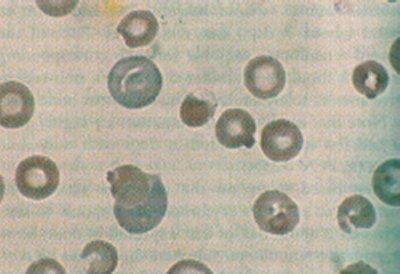
HEINZ BODIES First broadcast on www.provet.co.uk |
This information is provided by Provet for educational purposes only.
You should seek the advice of your veterinarian if your pet is ill as only he or she can correctly advise on the diagnosis and recommend the treatment that is most appropriate for your pet.
Heinz Bodies are often reported in red blood cells examined on blood samples...but what do they mean ?
Oxidative injury to haemoglobin protein results in the presence of Heinz Bodies - round protrusions of the red blood cell membrane which may appear with a pale staining "collar", or as a refractile area within, or overlying the red blood cells.

Three canine erythrocytes with large Heinz bodies (x330)
(Photograph from Diagnostic Cytology and Hematology of the Dog and Cat by Cowell, Tyler and Meinkoth (1999) Mosby. Used with the permission of Harcourt Publishers)
Susceptible cats may have <10% small Heinz bodies present in their red cells when they are healthy. Some chronic diseases increase the numbers and size of Heinz bodies in cat blood , including :
- Diabetes mellitus
- Haemolysis
- Hyperthyroidism
- Lymphoma
- Renal disease
In dogs large Heinz bodies are associated with
- Haemolysis
Oxidative injury can be caused by several toxins including :
- Drugs - paracetamol, analgesics (eg benzocaine)
- Onions - propyl disulphide
- Moth repellent - naphthalene
- Zinc
Last updated : October 2013